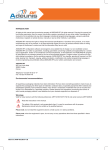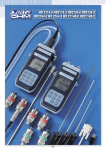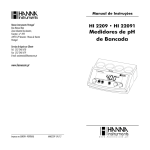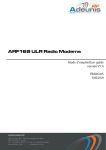Download ARF18 - 4033 User Guide
Transcript
ARF18 - 4033 User Guide PRESENTATION Description Functioning Visualisation 2 2 3 3 PROGRAMMING Assignment of a key to an output: Erasing all the links of an output: Erasing all the links of a key: General erasure: Visualization of all the links of a key: Manual cancellation of the outputs: OUTPUT WIRING CHAINING OF THE RECEIVERS 05-11-V3-ptr 3 3 4 5 5 5 6 6 6 ADEUNIS RF – 283 RUE LOUIS NÉEL – 38920 CROLLES FRANCE 1 DESK : +33 (0) 4 76 92 07 77 – FAX +33 (0) 4 76 08 97 46 E.MAIL : [email protected] ________________________________________________________________________________________ SA au capital de 345.000 euros – SIRET 430 190 496 00017 – RCS Grenoble – NAF 322A PRESENTATION The radio receiver ARF4033 runs within the 433 MHz European band. Its use does not require a license. It enables to drive up to 8 open collector outputs on monostable or bistable modes. It is meant to decode - after learning - the frames sent by the remote controls ARF2114B (2 keys) ARF2115C (4 keys) and ARF2115D (8 keys 24 ways). The receiver ARF4033 is intended for all the self-contained control applications of the tertiary or industrial equipment. An Adeunis-RF designed rolling code protects the transmission of the orders. Antenna Power supply C stands for common or voltage reference. Chaining Radio 4033 PRG AA E²PROM PROG valid Error Auto/Prog ARF4033AC AD020169 2002.11 Bistable. Monostable. A B C SELECT • Receiver “+” is switched power supply, OFF when programming. 8 C + 7 6 C + 5 4 C + 3 2 C + 1 RAZ Description The receiver is equipped with a jack type connector with a 2 mm. peg diameter (+ in centre) for the feeding. The feeding, by this connector, must be included within the following range: 9V. < +V < 24V. The receiver ARF4033 can be configured with a choice of two different running modes: • Monostable mode: the output reflects the key status. • Bistable mode: the output status changes after each press on the key. KEY Monostable bistable 05-11-V3-ptr 2 A toggle switch enables to switch from the regular mode to the programming mode. A LED points out the programming mode. In this mode, the SELECT button enables to select the output to assign and the RAZ button enables to delete the links that are already stored. In the regular mode, the RAZ button enables to shut off all the activated outputs. When more outputs are needed, the decoders can be chained. • Functioning The decoder ARF4033 receives the data transmitted by the remote controls through the radio receiver. The order received is compared to orders that are already memorized. If one occurrence is found, then the corresponding outputs are stimulated either by the pressing time of the key, or by the next press. The selection of the monostable or bistable mode is completed for the whole set of the ARF4033 decoder outputs. • Visualisation The receiver ARF4033 is equipped with a diode LED for each output. In regular mode, it displays the output status. In programming mode, this LED shows the output selected. PROGRAMMING • Assignment of a key to an output: This programming phase makes a link between a remote control key and an output: 1) Switch to the programming mode: the led PROG lights steadily. The outputs turn off. 2) Select the output by pressing the push button “select”. A short press shifts the output of one step, e.g. 2—> 3, and a long press enables to change the page, e.g. A—> B. The outputs and pages LED’s are updated according to the “select” action. 3) Press the remote control key to connect with the output selected in 2). The output LED flashes 5 times then switches off. The green LED is then lighting, validating the operation. Release the pressure on the remote control: the learning of the link is completed. 4) Go back to the step 1) to operate another learning or switch back to auto mode. Notes: • It is possible to learn up to 8 keys per output. The attempt to write a 9th key has no direct impact on the existing links and results in a flashing of the led PROG. 05-11-V3-ptr 3 • Several outputs of a same ARF4033 receiver may be driven by the very same key provided that these outputs belong to the same page A, B or C. Learning a key previously memorised in a different page is not valid and induces the led PROG to flash. Configuration example: ARF2114B ARF2115D ARF2115C i d a b f e g j h k c A B C A B C 1 2 3 4 5 6 7 8 Monostable 1 2 3 4 5 6 7 8 Monostable A B C 1 2 3 4 5 6 7 8 Bistable The link (b) is incompatible with the links (a) and (c), because a similar key drives two outputs from a similar receiver that do not belong to the same page. The links (e) and (f) coming from a similar key can be programmed because they head towards two separate receivers. • Erasing all the links of an output: This programming phase deletes all the links involved with an output. 1) Switch to the programming mode: the led PROG lights steadily. The outputs turn off. 2) Select the output pressing on the push button “select”. A short press shifts the output of one step, e.g. 2—> 3, and a long press enables to change the page, e.g. A—> B. The output and page LEDs follow one another as “select” is pressed. 3) Press the push button “RAZ” of the ARF4033 receiver. The output LED is flashing. 4) Hold the press on the push button “RAZ” until the LED switches off after a fast flashing. 5) 05-11-V3-ptr Release the push button, the link erasure is completed. 4 6) Go back to step 1) to delete the links with another output, or switch back to the auto mode. On the figure above, the links (d) and (e) will be deleted if the A8 output is selected. (f) and (g) if the B1 output of the second receiver is selected. • Erasing all the links of a key: This programming phase deletes all links between a remote control key and the associated receiver outputs: 1) Switch to the programming mode: the led PROG lights steadily. The outputs turn off. 2) Briefly press on the remote control key to suppress. The assigned output LEDs light. 3) Press the push button “RAZ” until the output LEDs flash. 4) Press again on the remote control key to suppress until the LEDs switch off after a fast flash of the green LED. Release the key: the erasure is done. 5) Go back to step 1) to delete other keys, or switch back to the auto mode. On the figure above, the links (a) and (c) will be deleted if the remote control key 2115C is selected, and only the link (e) if the remote control key 2114B is chosen. • General erasure: This programming phase deletes all the links of a receiver ARF4033: 1) Switch to the programming mode: the led PROG lights steadily. The outputs turn off. 2) Press the push button “RAZ” of the receiver ARF4033. The 8 output LED’s are flashing. 3) Hold the press on the push button “RAZ” until the LEDs switch off after a fast flashing. 4) Release the press button: the whole erasure of the memory is completed. On the figure above, all the links of (a) and of (e) will be deleted if the first receiver is chosen. • Visualisation of all the links of a key: This phase enables to see all the outputs associated to a remote control key: 1) 05-11-V3-ptr Switch to the programming mode: the led PROG lights steadily. The outputs turn off. 5 2) Briefly press on the remote control key: the assigned output LEDs light for a few seconds. 3) Go back to step 1) to visualise other keys, or switch back to the auto mode. • Manual cancellation of the outputs: This operation cancels all the outputs of a receiver without remote control. In regular mode, press the key RAZ until the active output LED’s switch off. OUTPUT WIRING The outputs are open collector type. Each output has one point for the open collector and one point for the commuted voltage. This commuted voltage is similar to the board supply voltage, but this voltage is switched off in programming mode and switch on in normal mode. For an output, the maximum current is 50 mA. A relay wiring is completed between two output terminals. The free-wheel diode is already wired on the card. +V Comm Output (n) The interface with an electronic card is obtained by connecting the grounds and by using a pullup resistor connected on the power supply of the card. +V Comm + 5V R Output (n) GND GND CHAINING OF THE RECEIVERS The receivers ARF4033 may be chained one after the other to increase the number of outputs, or to access the bistable and monostable modes. The head receiver ARF4033 must be equipped with a radio receiver (reference ARF4033A). The next ones must be receivers of the ARF4033B type. It is possible to connect up to 10 ARF4033B at the most, following a ARF4033A. 05-11-V3-ptr 6

















